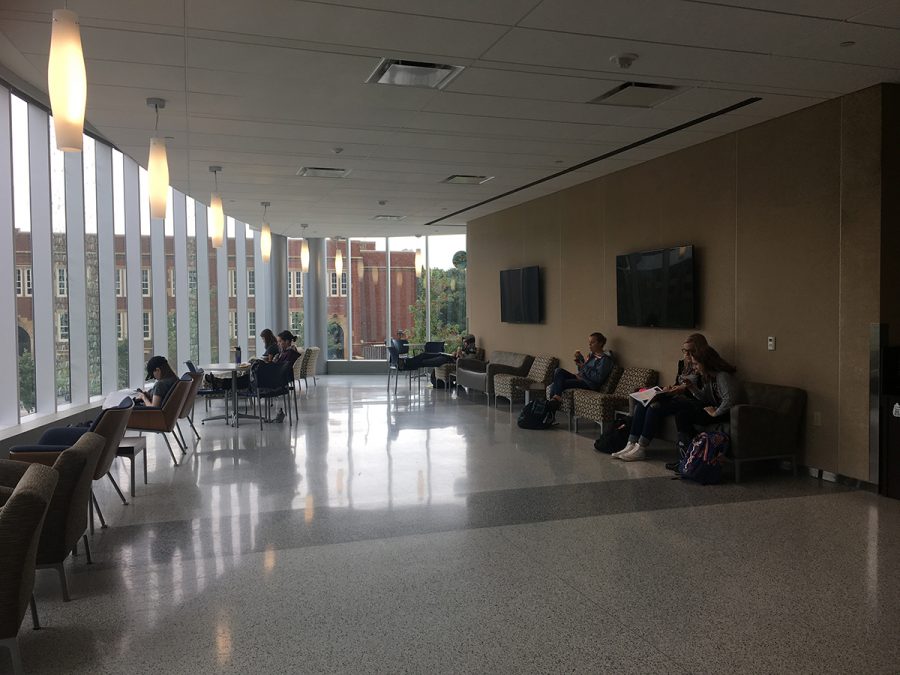UW-Eau Claire receives $5.5 million from the UW System
Chancellor Schmidt looks ahead after budget cuts; plans to patch holes left after budget cuts
The $5.5 million one-time distribution will be used to fund financial aid, a faculty compensation plan, the strategic plan and employing temporary instructors while hiring tenure seeking professors (Andee Erickson)
September 22, 2016
This is the introductory installment in which Erickson will look at the effects budget cuts are having on student’s academic lives.
Chancellor James C. Schmidt is ready to continue growing the campus again after the 2015-17 budget cuts, and he’s beginning with organizing how to spend a $5.5 million one-time distribution from the UW System.
“What I would love to do is turn that corner,” Schmidt said. “We have spent the last two years only focusing on budget cuts. We want to get back to focusing on our students and what is good for all of us.”
The $250 million cut in state funding to the UW System left UW-Eau Claire with $12.2 million to cut from its two-year budget. Instructional academic staff took the biggest hit proportionately during the cuts, which is why he was eager to put the new funds back into the teaching, he said.
The $5.5 million has been outlined to advance four areas on campus: financial aid, Academic Affairs and the strategic plan, while $3 million is funding a faculty compensation plan.
Most of the funds are a result of an unexpected decrease in employee’s fringe benefits costs, the chancellor said. The UW System projects the costs of fringe benefits in advance, but with 179 full-time equivalent employees cut on Eau Claire’s campus the cost of fringe benefits went down rather than up like expected, leaving another surplus to be distributed, he said.
The faculty compensation plan involves addressing equity issues among faculty and staff, the chancellor said. For example, a new employee might receive higher pay than a more experienced employee in the same department if the market has pushed the bidding rates up between when the experienced employee and the new employee applied.
Faculty and staff equity also means ensuring the pay rates are competitive to other schools as well as identifying any inequities around gender or race, he said. A working group of faculty and staff will recommend how to distribute the $750,000 beginning July 1, 2017.
Strong student enrollment and retention rates will allow these employees to continue receiving these equitable rates after the one-time distribution runs out, Schmidt said.
“For excellence to be here we needed to have the right faculty and staff here,” Schmidt said, “and what that means is we first needed to retain those great faculty and staff that we already have working for us.”
A working group will also determine how to distribute $2.3 million for merit increases to faculty and staff who adhere to the universities guidepost goals: 100 percent of students with a high impact experience, 90 percent retention rate, 50 percent of students graduating in four years and 20 percent of multicultural students.
State legislation gave the UW System permission to issue merit pay increase to faculty and staff in the 2015 session that determined the $250 million cut to the system, the chancellor said.
“Instead of just going out and hiring a lot of people to help us with the strategic plan I believe our employees are in the best position to move the institution forward,” the chancellor said. “And I am suggesting that each department recommend how they think they are best positioned to help.”
Of the one-time distribution, $813,000 is a result of lower utility costs. With this year’s mild winter and energy prices at an all time low, the UW System, which manages the heating, cooling and electrical costs of all UW schools, had a surplus in the utilities account and decided to distribute the money back to campuses, Schmidt said.
That money was allocated toward Academic Affairs to temporarily fill positions while hiring processes are taking place to fill positions where faculty resigned, said Stephanie Jamelske, the budget officer for the Academic Affairs office.
“I’m hoping that the arrival of some of these positions next year will start to feel like we are moving ahead,” Jamelske said, “like we have gotten some things settled after these long periods of transition.”
The resignations being filled are not a result of the voluntary separation incentive, Jamelske said, a program that invited employees to retire and accept a buyout in order to meet the demands of the 2015-17 budget cuts.
“The departments have been instructed to figure out a way to deliver the necessary course curriculum through the changes,” Jamelske said. “It’s a big transition year.”
Of the $5.5 million one-time distribution, $900,000 is required to be used as student financial aid and remaining $800,000 is being set aside to support the university’s strategic plan initiatives, which the chancellor said is small dollar amount for the scope of the plans and their importance.

